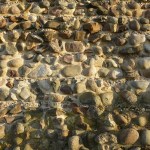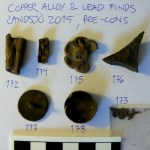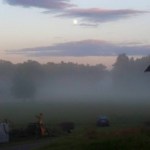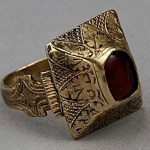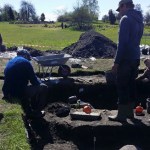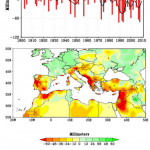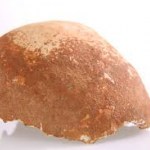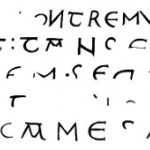archaeology
I spent last week in Denmark at a friendly, informative and rather unusual conference. The thirteenth Castella Maris Baltici conference (“castles of the Baltic Sea”) was a moveable feast. In five days we slept in three different towns on Zealand and Funen and spent a sum of only two days presenting our research indoors. The rest of the time we rode a bus around the area and looked at castle sites and at fortifications, secular buildings, churches and a monastery in four towns. Our Danish hosts had planned all of this so well that the schedule never broke down. Add to this that the food and…
Late Iron Age settlements are full of copper alloy objects, making them the preferred site category of metal detectorists. High Medieval castle sites, on the other hand, are quite poor in these often distinctive and informative finds.
The picture above shows all the copper alloy and lead that my team of ~15 found in over two weeks of excavations at Landsjö castle this past July, screening the dirt and using a metal detector in our trenches. Only seven objects! We collected 133 pieces of iron in that time, of which 77% are sadly nails in various states of completeness and thus not terribly…
2014 trenches A-E and rough locations of 2015 trenches F-H.
I write these lines on the day after we backfilled the last two trenches at Landsjö, packed up our stuff, cleaned the manor house, hugged each other and went our separate ways. It's an odd feeling to take apart the excavation machine while it still runs. It's been four fun and successful weeks!
Since my previous entry, written on Monday evening, we've done only three days of further excavation. Our main findings, to the extent that I have any comprehensive overview of them at the moment, relate to the culture layers sitting…
2014 trenches A-E and rough locations of 2015 trenches F-H.
Like Stensö, Landsjö Castle has half of a rare perimeter wall and is known to have been owned by a descendant of Folke Jarl – or rather, by his daughter-in-law, the widow of such a descendant. Last year we found that the high inner bailey has a previously unseen southern wall with a square tower at the east end, and we found five coins of AD 1250-75 in a deep layer that seem likely to date the castle's construction phase. But unlike Stensö, in three strategically placed trenches we found no trace of the missing bits of the…
Balancing available labour and a pre-decided excavation agenda against each other is not easy, particularly when you're doing investigative peek-hole fieldwork on a site whose depth and complexity of stratification you don't know much about. At Stensö we had two of three trenches and all five test pits backfilled in time for Wednesday lunch's on-site hot dog barbecue. Ethan Aines, Terese Liberg and three students stayed on to finish trench F, while myself, Mats Eriksson and six students moved to our new base at Landsjö Manor.
Trenches D and E and the test pits produced no big news after my…
This year's first week of fieldwork at Stensö Castle went exceptionally well, even though I drove a camper van belonging to a team member into a ditch. We're a team of thirteen, four of whom took part in last year's fieldwork at the site. All except me and co-director Ethan Aines are Umeå archaeology students. We're excavating the ruin of a castle that flourished in the 13th and 14th centuries. This year we have a very nice base at Smedstad, let to us by the genial B&B host Hans-Ola. But we cook our own meals, each day having its designated cooks and dishwashers, and in the evenings we…
Issue 2014:4 is now on-line on Open Access.
Otto Blehr on Stone Age elk hunting in northern Sweden.
Laila Kitzler Åhfeldt on the terminology used by 11th century rune masters to denote their own work.
Pia Bengtsson Melin on High Medieval magic rings.
Timo Salminen on a 20s & 30s debate over whether the Corded Ware megaculture reached Finland via Sweden or directly from the Continent.
Reviews.
Last year I headed four weeks of excavations at two previously unexplored castle ruin sites near the Swedish city of Norrköping: Landsjö in Kimstad and Stensö in Östra Husby. Finds and written sources suggest that both were built and inhabited in the 13th and 14th centuries. All known owners were members or close relatives of the powerful Ama family. Now Ethan Aines and I have finished the archive reports, available here on ScienceBlogs [Landsjö and Stensö] and on Archive.org. Rudolf Gustavsson's osteological reports (in Swedish) are included. Comments and questions are most welcome…
When I tell people I'm an archaeologist, they often ask ”So have you dug at Birka?”. As of yesterday I can finally proudly reply ”yeah, a bit”.
”Birka” is a Latinate attempt to write Biærkey, ”Birch Island”. It's an island in Lake Mälaren, two hours by slow boat from Stockholm. For a bit more than 200 years starting in the mid-8th century, it hosted the first town on Swedish soil, established there as a regulated international trading post under the protective (and probably tax-grabbing) hand of the Kings of the Swedes. This immortally classic Viking Period site has huge cemeteries, a huge…
Afternoon tea with my friends Åke and Petra inspired me to re-run this post from March 2010. Professional dendrochronology is still almost entirely a black-box in-house endeavour, that is, it is still not great science. Field archaeologists: when you saw your wood samples for dendro, get two samples and send one to the amateur community! They practice open data sharing. Check out Åke & Petra's web site!
How long ago was the time of Emperor Augustus? Most educated people, including professional historians and archaeologists, will reply "about 2000 years" if you ask them. But a…
The Archangel Raphael. Recently uncovered mural in Kil church, Närke. C. 1250.
Today's my 16th anniversary as editor of Fornvännen! Issue 2014:3 is now on-line on Open Access.
Ole Thirup Kastholm on dugout canoes from before AD 1 on the Scandinavian peninsula.
Ole Stilborg on Late Bronze Age pottery from Östergötland.
Peter Tångeberg on recently uncovered Medieval murals in Kil church, Närke.
Påvel Nicklasson on early 19th century archaeological innovator Sven Nilsson’s female correspondents and on hints that Nilsson may have turned to folk magic when seasick.
Olof Holm on Iron Age metal…
Dear Reader, it is with great pleasure that I announce the PDF publication of my fifth monograph,* In the Landscape and Between Worlds. The paper version will appear in April or May. Here's the back-cover blurb.
Bronze Age settlements and burials in the Swedish provinces around Lakes Mälaren and Hjälmaren yield few bronze objects and fewer of the era's fine stone battle axes. Instead, these things were found by people working on wetland reclamation and stream dredging for about a century up to the Second World War. Then the finds stopped because of changed agricultural practices.
The objects…
Having read yesterday's entry about what I need to get hold of before I can dig a site, Apel Mjausson asked me on Facebook, "How do you decide where to dig? Sweden is lousy with unexplored sites. Are you following a specific story, looking at place names, take nominations...?"
Disregarding sites I've been paid to dig and sites I've only metal-detected,* my motivations have been as follows. To begin with, I only ever dig sites that I judge likely to produce something publishable and exciting. (And sometimes I lose on that gamble).
At Barshalder in 1997 I dug two graves because at my advisor's…
I've headed my own research excavations since 1996. Now I'm preparing for four weeks of fieldwork during the upcoming season. I operate as an independent scholar in this context, and none of my excavations have been prompted by land development. Here's what I need to get hold of before I can break the turf or metal-detect the plough soil on an archaeological site in Sweden.
Contacts/notoriety. I couldn't get much of what's listed below without contacts/notoriety in the business.
Funding. Most of my research money comes from small private foundations in annual instalments of about $3,600 (€3,…
OK, I admit the title of this post is possibly a bit extreme but I could not resist the symmetry. Here, I refer to both ends of civilization, the start and the finish.
I'd like to talk about a recent review published in Science, titled "Systems integration for global sustainability" written by my colleague Peter Gleick of the Pacific Institute together with Jiangou Liu, Harold Mooney, Vanessa Hull, Steven Davis, Joane Gaskell, Thomas Hertel, Jane Lubchenco, Karent Seto, Claire Kremen and Shuxin Li. But I want to put this paper in a broader perspective, dipping into my training as an…
Manot Cave cranium
With a skull and Keats, there was little choice but to write about the new online items in rhyme. So with apologies to Shakespeare, Keats and the scientists, as well as the people at SpaceIL, here are today's grab bag of poems. As usual, follow the links.
On a Lone Cranium
Alas poor Yorick – We can only know
Where you lived all those eons ago
Walking, did you take those others in stride;
Human, yet strange, as they strode alongside?
Did your children wander forth,
Searching for a greener North?
Can your skull, a bit of bone,
Tell us where our seeds…
You'll recall that a while back, Greenpeace activists entered a restricted zone in Peru, where the Nasca Lines are preserved, and messed with that important archaeological site. I wrote about it here.
At the time, the individuals who had carried out this unthinkable act managed to drift off into obscurity, and Greenpeace seemed unwilling to provide Peruvian authorities with their names.
Now, they have done so. Partially.
From Bloomberg Businessweek:
Greenpeace has provided Peruvian authorities with the identities of the four foreign activists principally responsible for vandalizing the…
Fornvännen 2014:2 is now on-line on Open Access.
Hans Göransson on Middle Neolithic vegetation history.
Frans-Arne Stylegar reinterprets a famous Viking Period grave find with smith's tools.
Ronnie Carlsson & Christian Lovén on the urban parish churches of Medieval Uppsala.
Anders G. Nord & Käte Tronner analyse the paint residues on Medieval church sculpture and murals.
Påvel Nicklasson on Eva Brag and Ida Nilsson, two Swedish women in 19th century archaeology.
Håkan Svensson argues that the current setup of Swedish contract archaeology and metal detector legislation poses a constant…
Fornvännen 2014:1 is now on-line on Open Access. We've had trouble with our on-line archive for more than a month. This was because the UV units, Sweden's largest contract archaeology organisation, moved from the umbrella of the National Heritage Board to that of the Swedish History Museum. The IT folks were super busy with the move, but now they've got Fornvännen's stuff up and running again.
Sven Kalmring on evidence for contacts with Eastern Europe from the Viking town Hedeby.
Anne Monikander on Early Iron Age strike-a-light stones.
Robin Lindblad on Viking Period fishing and sheep…
Things are coming together with the post-excavation work for last summer's castle investigations so I'm putting some stuff on-line here.
I've submitted a paper detailing the main results to a proceedings volume for the Castella Maris Baltici symposium in Lodz back in May. There are no illustrations in the file, but you'll find all you need here on the blog in various entries tagged ”Castles”.
Osteologist Rudolf Gustavsson has completed his reports on the bones from the two sites (Landsjö – Stensö).
For the Dear Reader who doesn't read Swedish, a short summary of Rudolf's results is in order…
